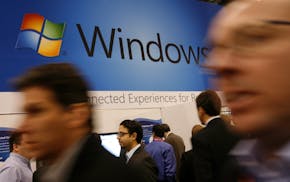Q: My work PC has some malware that produces unwanted messages, and sometimes I have to quit a program to get rid of them. I've been told that I'll need to completely reformat the C drive to get rid of the malware. How would I do that, and is it necessary? I work for a nonprofit, and our software budget is pretty limited.
Bev Mello, Maple Grove
A: Reformatting your C drive and reinstalling Windows should only be done as a last resort, and then only after backing up all your data. A better first step is to use the free version of the Malwarebytes security program at tinyurl.com/lm3wdcb.
Then make sure you have antivirus software. If you don't, and are using Windows Vista or 7, you can download the free Microsoft Security Essentials (tinyurl.com/aakal9b). Read the explanatory note to be sure you download the correct version (either 32-bit or 64-bit) for your PC. Windows 8, 8.1 and 10 have their own security software.
It's worth noting that your situation isn't unusual. Here are some ways to avoid downloading unwanted software that produces altered Web searches, new home pages or unexpected messages (such as advertising or bogus warnings that your PC is infected):
• Be vigilant when downloading free software. Sometimes you'll be able to opt out of these extra programs during installation. Other times you'll need to choose "custom" installation to opt out of extra programs. Avoid the "express" installation that installs everything.
• Don't download free toolbars for your Web browser. While toolbars offer easy access to frequently visited websites, they may include unwanted software that can pose a security threat or slow down your PC by using additional memory (see tinyurl.com/poag95w).
• Don't download free software from the "sponsored" links (which are paid advertising) found at the top of Web search results. These downloads often contain unwanted programs.
For more information, see "How to avoid installing software you don't want" from Consumer Reports (tinyurl.com/ox3kqgg).
Q: I set Google Chrome as my default browser on Windows 10, but sometimes Microsoft's new Edge browser suddenly pops up with an advertisement. Why? And isn't Microsoft required to let us disable or uninstall its browser and use a different one?
John Knoderer, Manning, S.C.
A: Make sure the Edge browser's pop-up blocker is turned on. Click on the three dots at the top right of the browser and select settings. Scroll down and click "view advanced settings," then turn on "block pop-ups."
Under the 2001 settlement of the Microsoft antitrust case, non-Microsoft browsers can easily work with Windows, but the firm's own browsers can't be eliminated.
E-mail tech questions to steve.j.alexander@gmail.com or write to Tech Q&A, 650 3rd Av. S., Suite 1300, Minneapolis, MN 55488. Include name, city and telephone number.

Alexander: A beeping computer is telling you what's gone wrong inside

Alexander: How to stop deleted iPhone e-mails from coming back

Alexander: Refurbished PCs may need a BIOS update to use new components

Alexander: Windows 11 not always to blame for browser or e-mail problems


